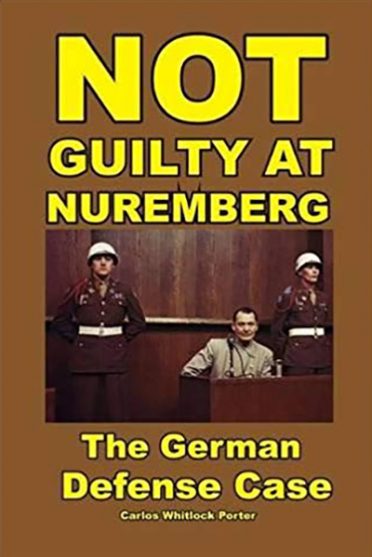Description
Not Guilty at Nuremberg: The German Defense Case
By Carlos Porter
Uninformed people consider the “Nuremberg War Crimes Trials” as the ultimate proof of the guilt of the German leadership before and during World War II. The transcripts of the proceedings, however, tell an entirely different story.
This volume contains the defense arguments put forward by the main defendants at the trials. It shows that the trials broke every legal precedent and procedure of evidence in the book.
Defendants were refused the right to cross-examine “witnesses”, blatantly forged documents were accepted as genuine without question, and evidence indicating torture of suspects was struck out by order of the judges.
In addition, the blatant contradictions in the prosecution arguments (which saw the Germans charged with the exact same behavior as exhibited by the Allies during the war), combined with the persuasive counter arguments from the defendants themselves, provides a fascinating insight into the 1946 lynch-mob proceedings which masqueraded as “trials”.
Softcover, 60 pages. $10 #825
Reviews
I enjoyed the book. It pointed out TRUE facts about this trial and the defendants, which were withheld from the public at that time and for years to come. The premise basically shows the reader how were this trial in fact a “fair trial of justice”, the judgments against some of the defendants would and should have been somewhat different. … It is an unbiased telling of the actual facts, as we today know them. It claims no innocence of any of the defendants particularly, but points out the many mitigating circumstances that were purposely ignored by the Allies. – Amazon Customer, Amazon.com.
A concise narrative and well researched that gives a revised and perhaps a true account of the Nuremberg trials and lack of justice therein. It was a little short though, I read it in about 4 hours, but it explained a lot. – Jim Hunter, Amazon.com.
Excerpt
THE RE-WRITING OF HISTORY is as old as history itself.
The Annals of Tacitus, for example, mention a “rumor” that Nero burned Rome; this “rumor” was repeated by later Roman historians as “fact”. Later writers called this “fact” into question, and demoted the “fact” to mere “rumor”.
In 1946, it was a “proven fact” that Nazis made human soap. This “fact” has since become, apparently, merely “rumor” (Hilberg, Destruction of the European Jews: “To this day, the origin of the soap making rumor has not been traced”). The forensically untested “rumor” of Soviet origin (a jar of mysterious stinking material, Exhibit USSR 393) is in the Peace Palace of The Hague. Peace Palace officials show it to eager visitors and tell them it is authentic; but do not, apparently, answer letters from persons asking to have it tested.
In 1943, it was a “rumor” that Nazis were steaming, frying, parboiling, electrocuting, vacuuming and gassing Jews. By 1946, the “gassings” had become “fact”, while the steamings, fryings, parboilings, electrocutions and vacuumings remained mere “rumor”.
The “evidence” that Nazis “gassed” Jews is qualitatively no better than the “evidence” that they steamed, fried, parboiled, electrocuted, or vacuumed them. It appears legitimate to call this “evidence” into question.
This book contains not a re-writing of history, but a simple guide to historical material which has been forgotten. The 312,022 notarized defense affidavits presented at the First Nuremberg Trial have been forgotten, while the 8 or 9 prosecution affidavits which “rebutted” them are remembered.
Whether the statements of the defense are more credible than the human soap, human hair socks and cannibal hamburgers of the war crimes prosecutors is for the reader to decide.
